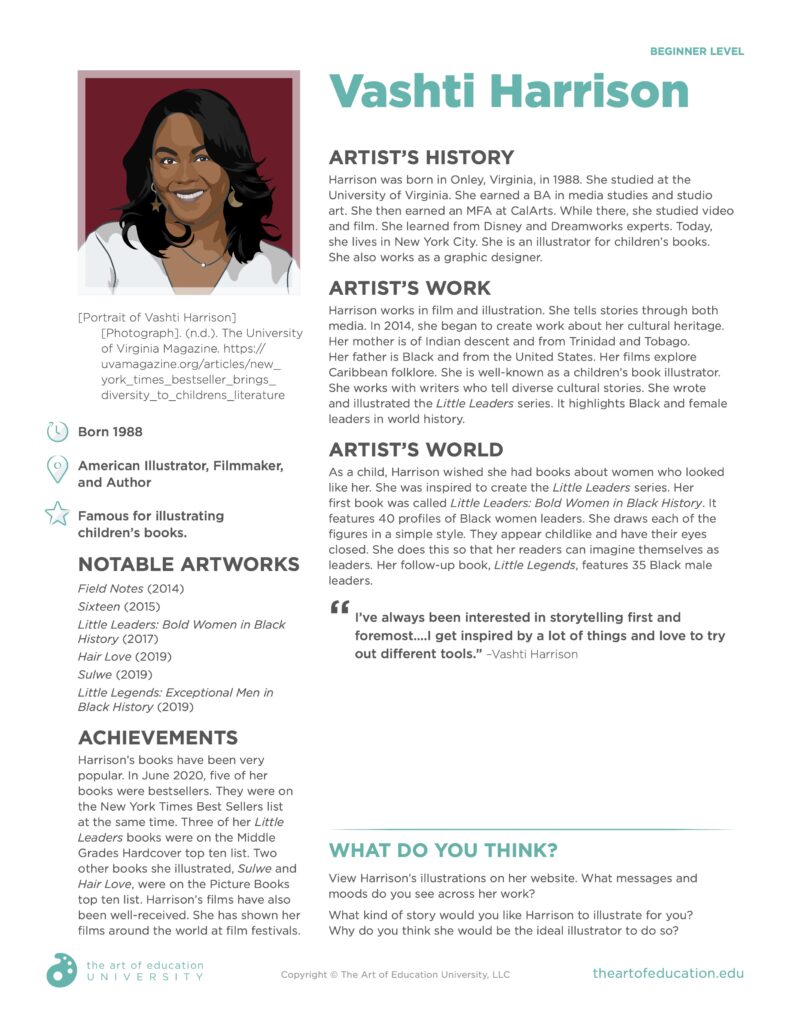
Art history can be a challenge to teach and incorporate into non-art history classes. How do you stay up-to-date on contemporary artists and current events in the art world? How do you get students hyped about examining artwork and asking good questions? Build small steps into your routine to make art history accessible and exciting with the ideas below. Don’t be surprised—you may become a self-proclaimed art history nerd, and your students will explode with connections that increase engagement and make their artwork more meaningful!
Discover fresh artists, new ways to look at old favorites, and fun strategies to get your students hooked on art history!
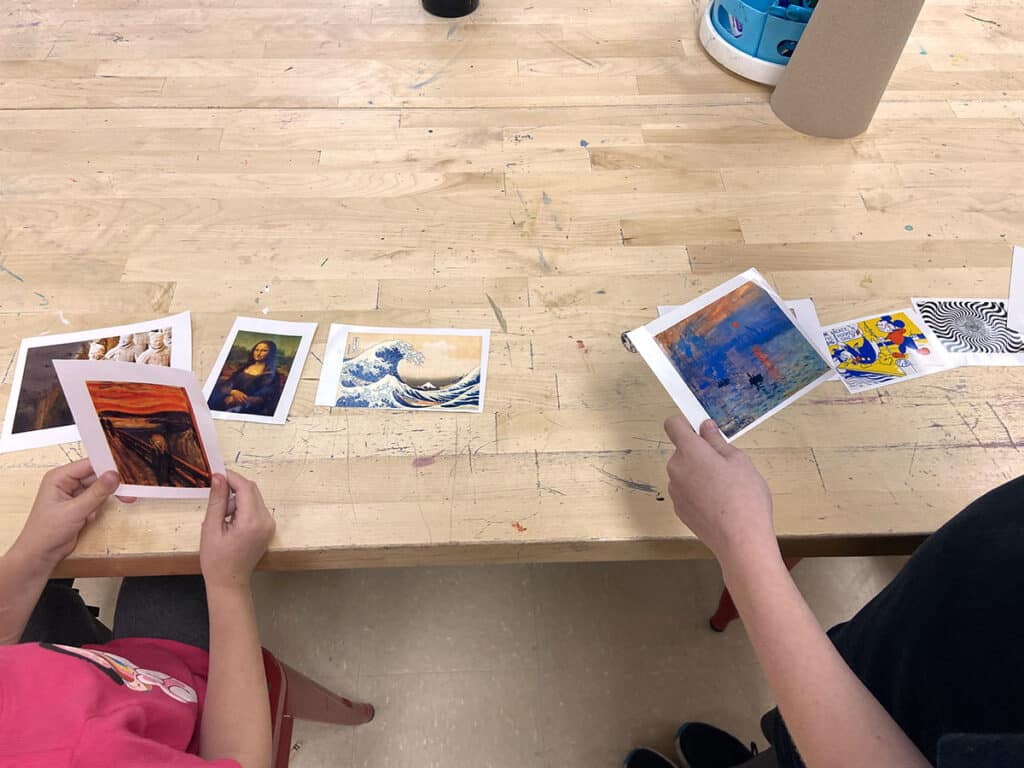
No one knows artists that students will find intriguing like another art teacher. A recent poll over at The Art of Ed Community asked, “Who’s your favorite lesser-known artist?” and the results were amazing.
Here are four great artists fellow art teachers recommend:
- Serena Rios McRae
McRae is an artist and mental health advocate. Students will love the accessibility of her pink eraser prints. McRae provides a great introduction to printing with found objects, but you can also connect to other forms of relief printmaking or compare with historical printmakers such as Hokusai and Durer. - Faig Ahmed
Ahmed is a contemporary Azerbaijani artist who reimagines traditional carpet weaving. Ahmed’s incorporation of surprising distortions and glitches creates mind-bending sculptural forms. - George Ohr
Ohr embodies the idea that art can be both technically skilled and wildly imaginative. Ohr is known as “The Mad Potter of Biloxi” for his playful manipulation of clay. Ohr creates crumpled, folded, and dramatically glazed pieces, making him a compelling ceramicist who explores the boundaries of form and self-expression. - Bisa Butler
Butler is a contemporary artist who creates stunning, life-sized quilted portraits of African Americans, often drawn from historical photographs. Her work can provide a wonderful introduction to not only fibers or collages but also portrait lessons and conceptual work tackling representation and activism through art.
If you’re looking for quick overviews of artists just like this, the Artist Bios in FLEX Curriculum will be your newest favorite feature! Whether you need classic master artists or fresh contemporary artists, FLEX has a vast archive searchable by themes, subject matter, media, elements and principles, movement, and connection.
Each Artist Bio is written at an 8th-grade reading level but some also have a 3rd-5th grade reading level. They include an illustrated artwork or portrait, at-a-glance facts, notable artworks, a quote, a short background, and reflection questions. There is also an Artist Bio Toolkit that includes artist lists, FLEX Lesson connections, a blank Artist Bio template, and innovative ways to use Artist Bios. Check out how amazing Artist Bios are by downloading the complimentary bio of Vashti Harrison below.
Take a few minutes to make new discoveries a regular routine.
Learning about the vast history of art from around the world and discovering new great artists can be as daunting for you as it is for your students. The key is to find small, manageable steps to learn a little more every day. Here are a few strategies you can use to make art history a regular part of your routine that you and your students will look forward to.
Watch 5 Minutes of Art History on YouTube.
Joe Boatfield and Harris Waltuck give you a crash course on a contemporary artist along with classroom applications for elementary and secondary in only five minutes! Each strategy and activity is teacher-tested and classroom-ready. Make sure you’re subscribed so you don’t miss a new episode.
Listen to art history podcasts.
There are numerous podcasts available to liven up your daily commute or prep period. Podcasts are also fun to play during independent work time to help students ponder and discuss fun facts while they create. Plus, they naturally encourage students to be fully present in class. If you’re not sure what podcasts or music will pair well with your lesson, The Art of Ed Community has playlists to set the right vibe for your classroom.
Share a quote of the day or quote of the week.
How artists present their work is a critical part of the work. Posting a quote from an artist will help students learn about art history through the words of the artists themselves. Pull quotes directly from FLEX Artist Bios and discuss them with students for a quick and meaningful bellringer activity.
Spark a lively debate!
Students love to share their opinions and a friendly competition can push them to work harder. Over in The Art of Ed Community, Christina Fogel shared a strategy called This or That. Post a slide with two artworks. Students will move to different sides of the room based on their artwork preference and then will share their “why.” This activity is fast to prep and works as a bellringer, movement break, transition activity, or exit ticket.
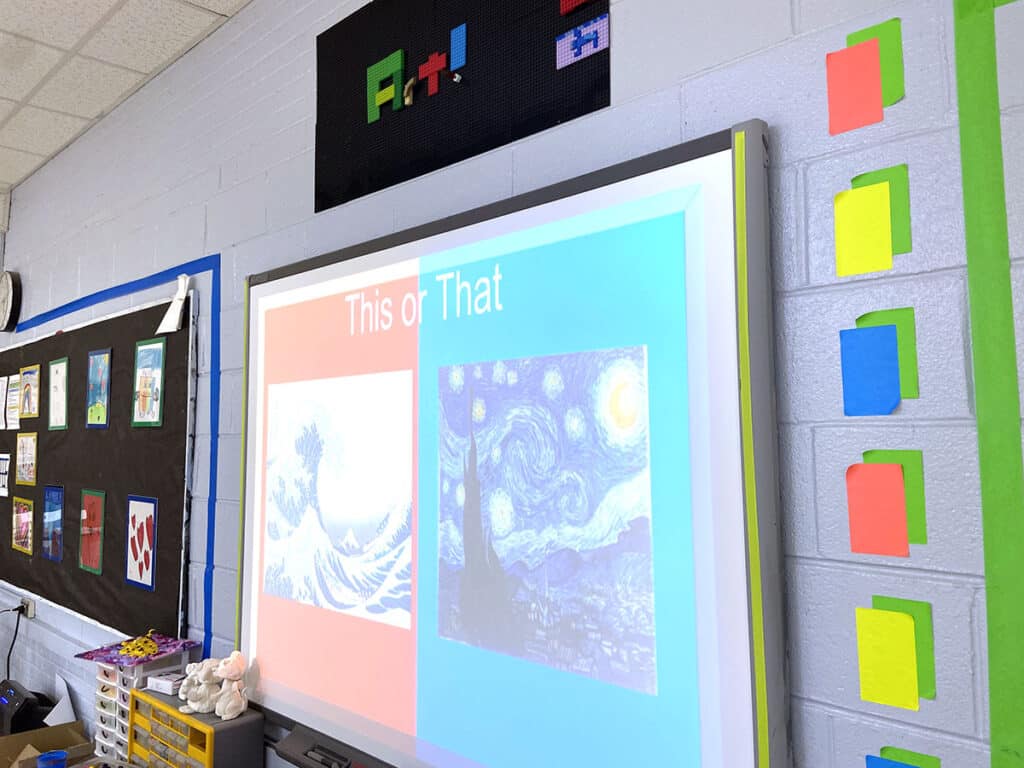
Build understanding through daily exercises.
Implement art history activities with a consistent sequence for each day of the week. Not only does this provide stability and clear expectations for students, but it also streamlines your planning. Keriann Kirkeng shared her breakdown in The Art of Ed Community. Monday, look at the artist and artwork title, medium, and year. Tuesday, draw a section of the artwork and list the elements and principles they see. Wednesday, write what they think the artwork is about and how it makes them feel. Thursday, write what they like or don’t like about the piece and why. Friday, share a fun fact about the artist and artwork and compare it with another artist and artwork.
Prompt students to respond thoughtfully and make connections to artists.
See/Think/Wonder is a popular framework to get students to examine an artwork with curiosity. It guides students in an introductory inquiry activity and eliminates rushing and shallow responses. You can use this strategy for artifacts or artwork. Ask the students what they see, what they think about it, and what it makes them wonder. The more you use this approach, the less prompting you will have to do as the facilitator.
You may notice some themes when students respond to artwork! People often respond to art through three main lenses. A formal approach focuses on visible aspects of the artwork such as technique, style, and symbolism. A personal approach makes connections in relation to the artist’s biography. A cultural approach examines influences of class, race, and/or religion.
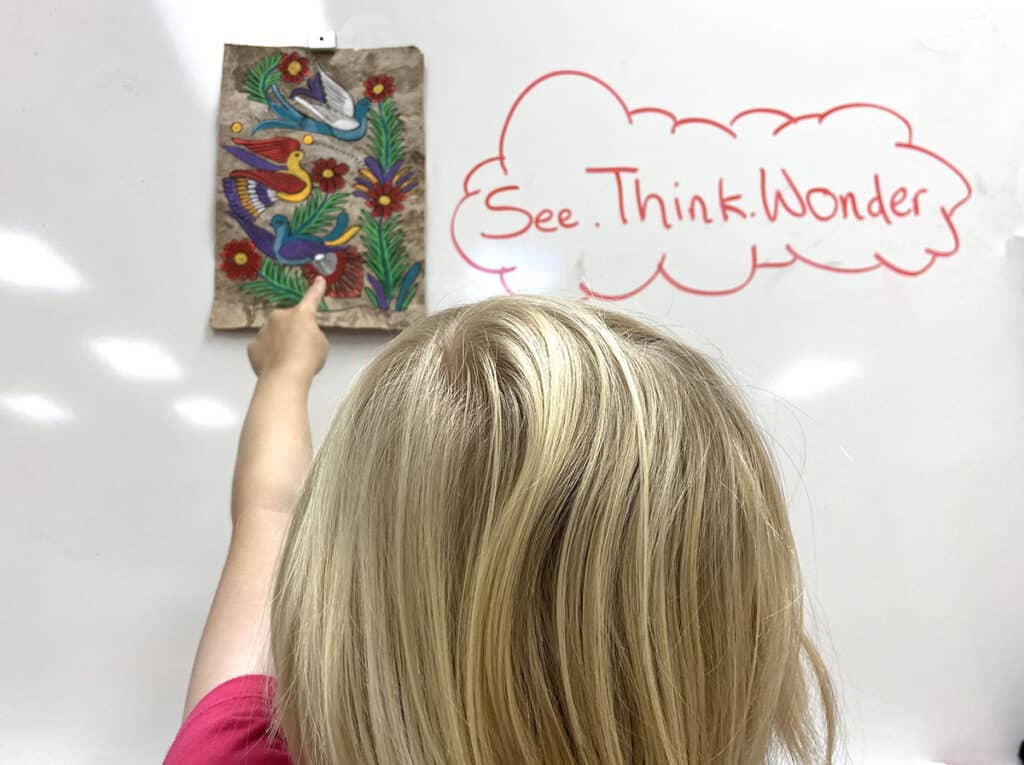
Make art history fun!
Games inject excitement into any lesson. They transform potentially dry facts into interactive and memorable experiences. Tapping into students’ natural love of play will increase engagement, lower anxiety, and foster deeper understanding.
Here are five fun ideas to get your students buzzing about art history:
- Mystery Masterpiece
This is a variation of the classic grid drawing method. Grid an artwork and cut it up. Give each student in the class a square of the grid. Label the back of each piece with a code so you’ll know where it fits in the larger image. As students complete larger drawings of their squares, arrange them in place. Offer a prize to the first student who can identify the mystery masterpiece! - Guess the Artist
Project an artwork on the screen for students to guess the artist based on their knowledge of styles, techniques, and subject matter. To make it more challenging, include lesser-known works by famous artists or provide clues related to the artist’s life and historical context. Add a little excitement to the game by covering the image with boxes you remove one at a time to slowly reveal the image. - Art History Timeline Challenge
Divide the class into teams and provide each with a set of image cards with artwork representing different periods or movements. Teams race to arrange their cards in chronological order, fostering collaboration and understanding of the historical progression of art. - Odd One Out
Think of a unique connection artists or artworks might have. Examples can be artists who depict food, artists who use toys, self-taught artists, or artists who studied for a different profession. After assembling your collection, add one that doesn’t fit the category. Challenge students to figure out what most of the group has in common and which one doesn’t belong. - Let’s Party!
Use the birthday calendar in the The Art of Ed Community and make an event to remember! Students can make artwork in the style of the artist they are celebrating, such as a cake in a Pop Art style for Andy Warhol.
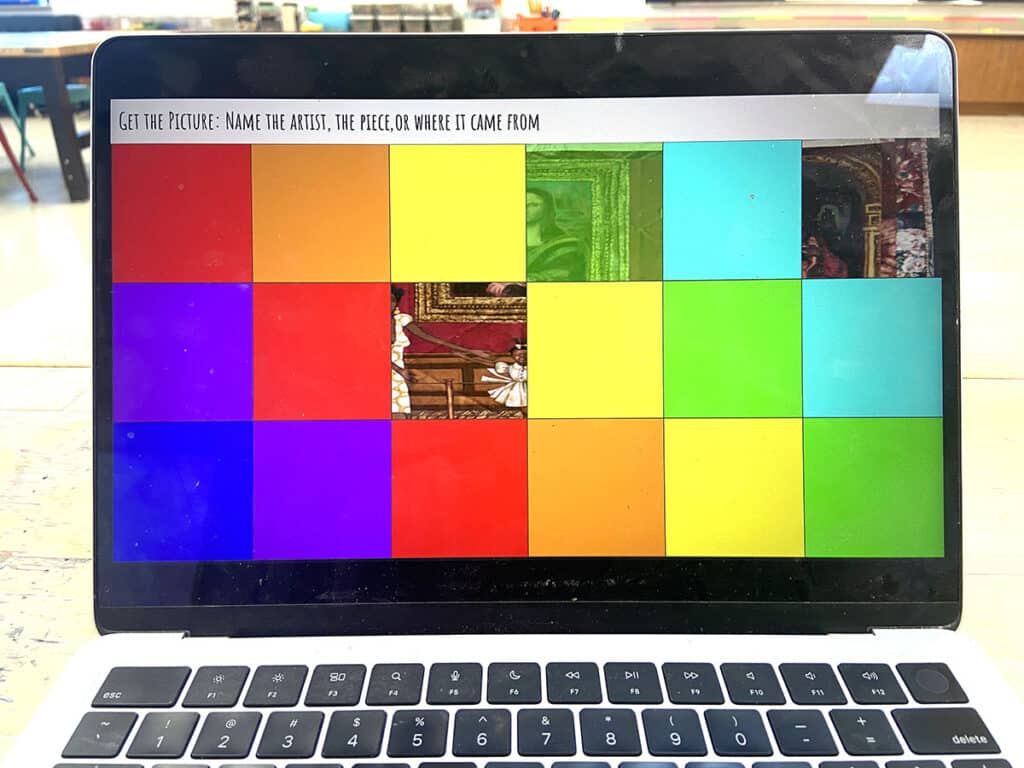
Give historical works a glow-up.
Challenge students to “fix” a classic and bring it up to date with contemporary styling. For example, recreate the Mona Lisa in contemporary clothing or replace fishing boats with surfers in The Great Wave Off of Kanagawa. Successful parody requires careful study of the original subject. Students will identify what makes a work seem dated and will also think about how historical figures would relate to contemporary culture. This creates interesting connections that bring new life to classic works.
For an even more complex task, give students two works of art. Challenge students to merge them together into one artwork. What characteristics, color schemes, and subject matter would transfer? How would they unify two different compositions and concepts together?
Art history doesn’t have to be scary—discover refreshing artists and strategies that will invigorate your teaching practice and curriculum and ignite your students’ curiosity. Incorporate small bellringer activities like This or That or Guess the Artist to make learning fun and streamline your planning. Bring in interactive games or See/Think/Wonder to boost active participation and welcome a breath of fresh air into your art room. Empower your students with communication and critical thinking skills to engage with artists, artworks, and artmaking this school year and beyond.
Who are your favorite lesser-known artists?
How do you get students excited to analyze art?
To continue the conversation, join us in The Art of Ed Community!
Magazine articles and podcasts are opinions of professional education contributors and do not necessarily represent the position of the Art of Education University (AOEU) or its academic offerings. Contributors use terms in the way they are most often talked about in the scope of their educational experiences.


